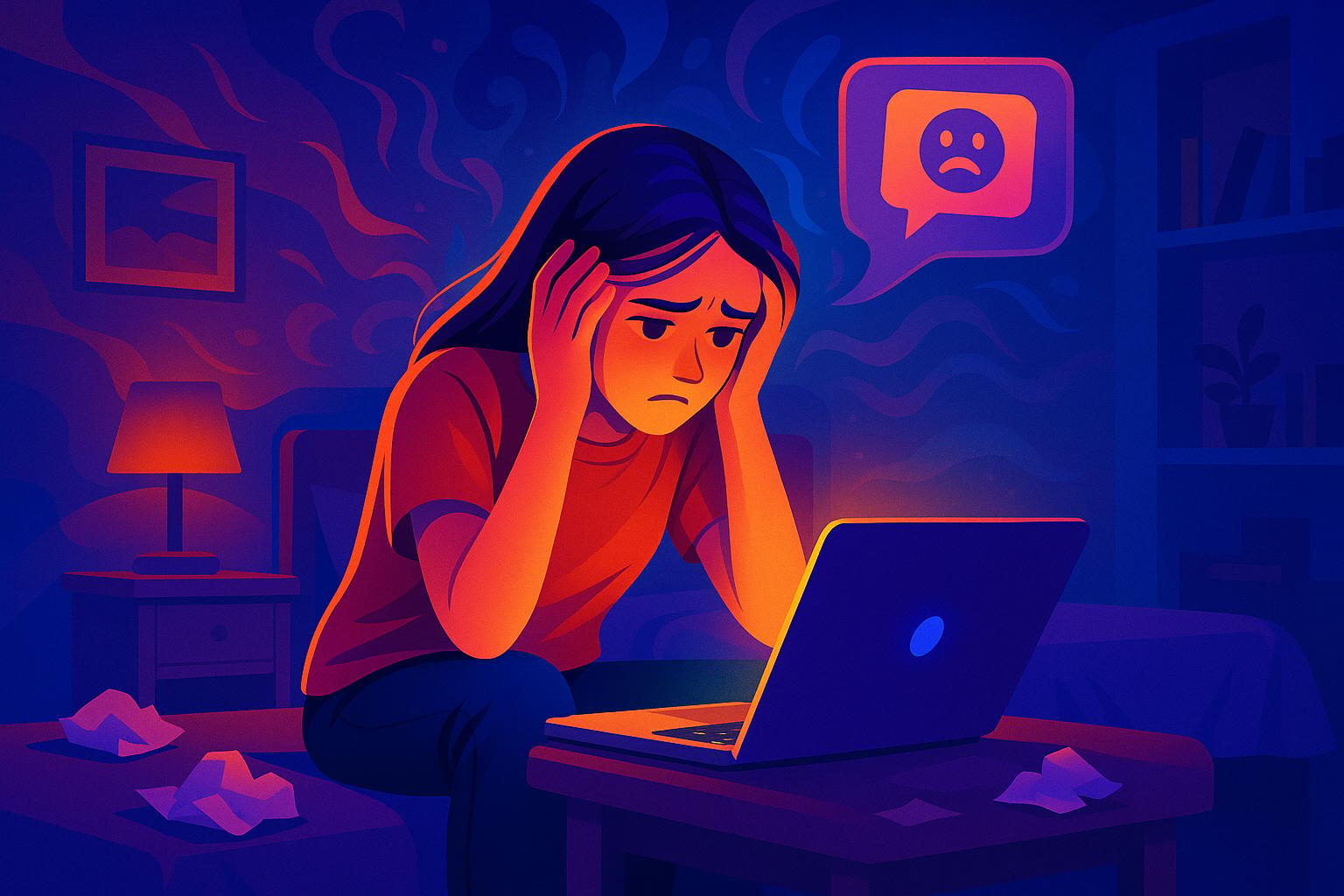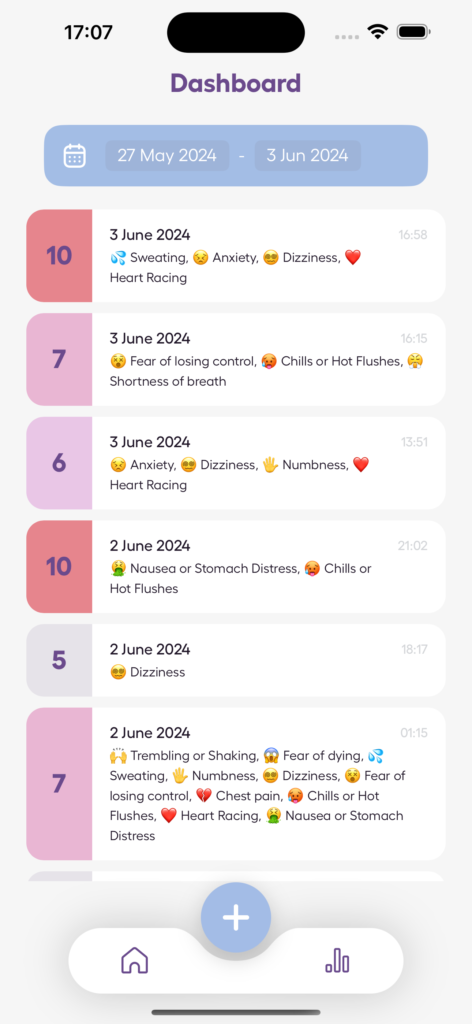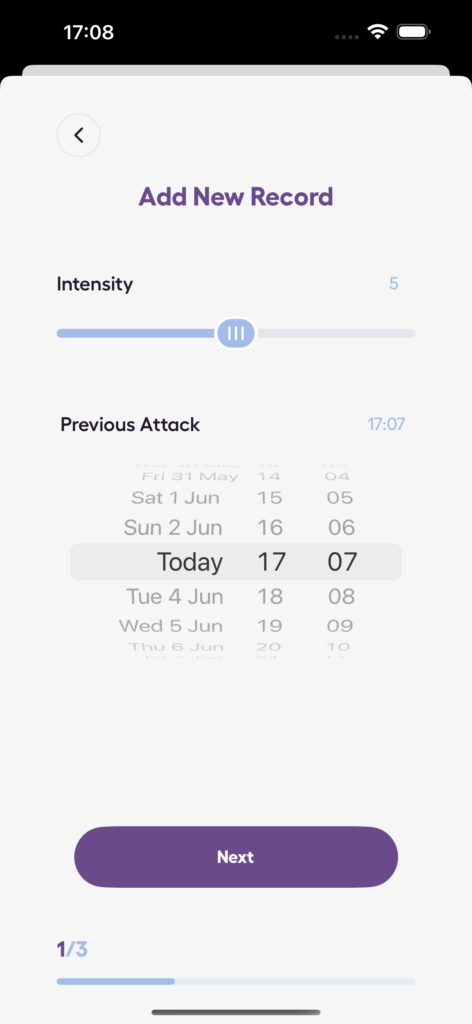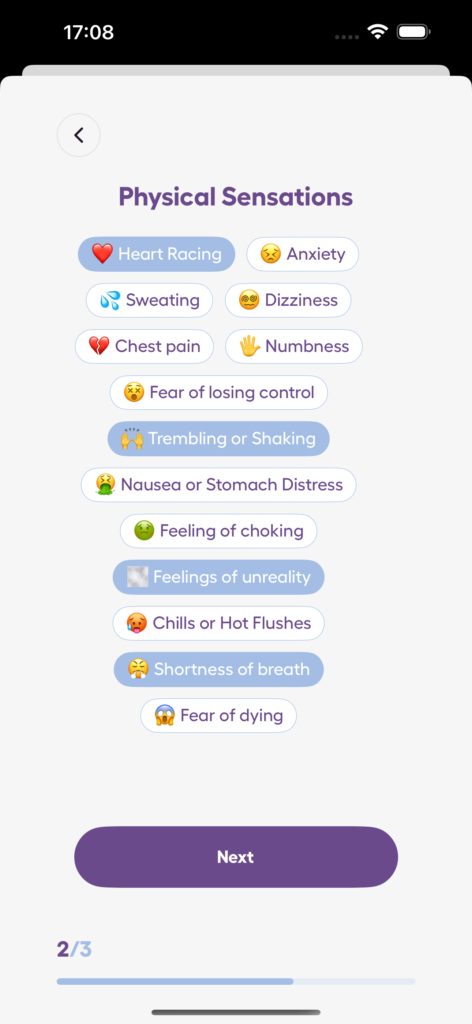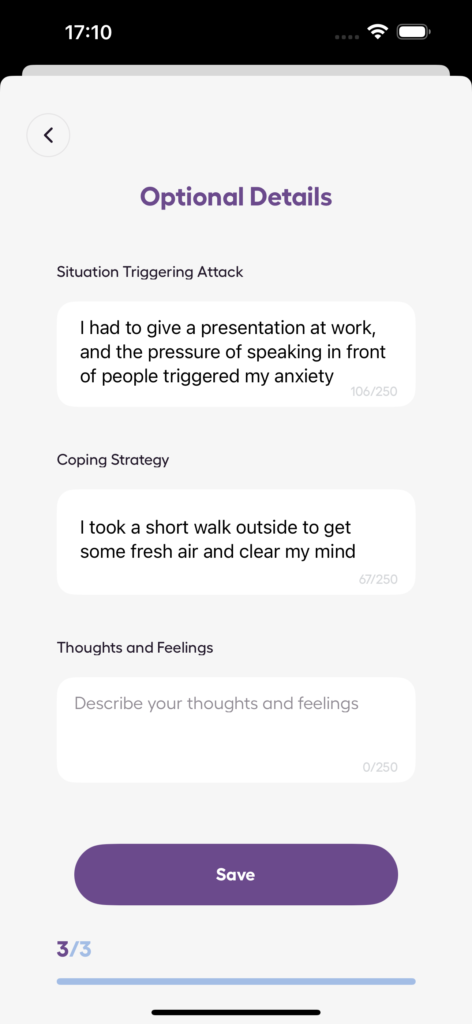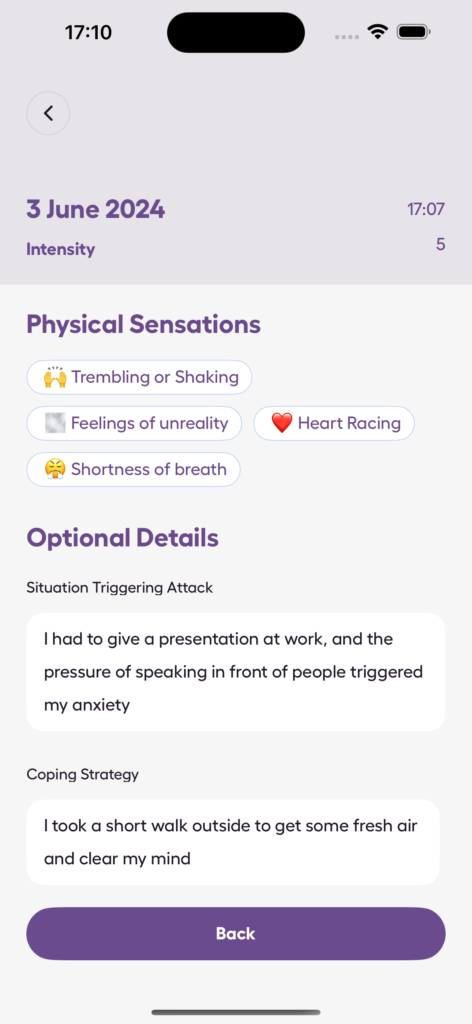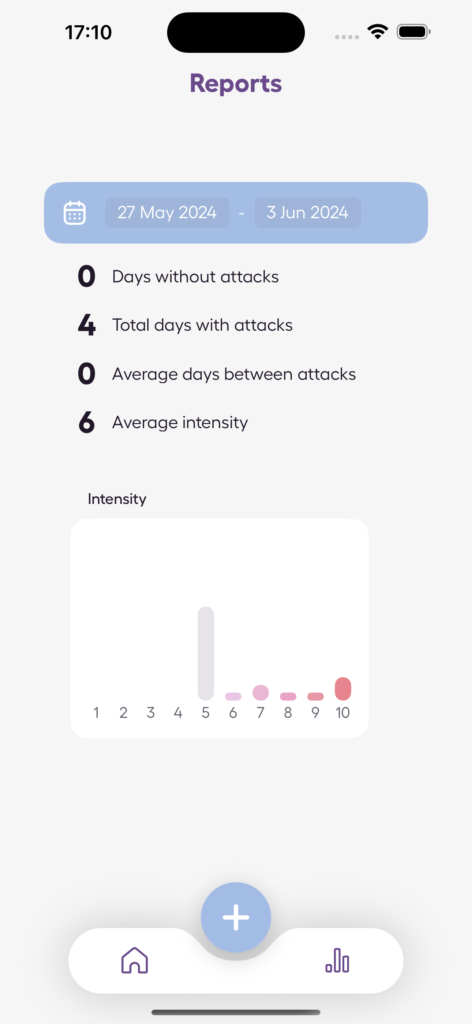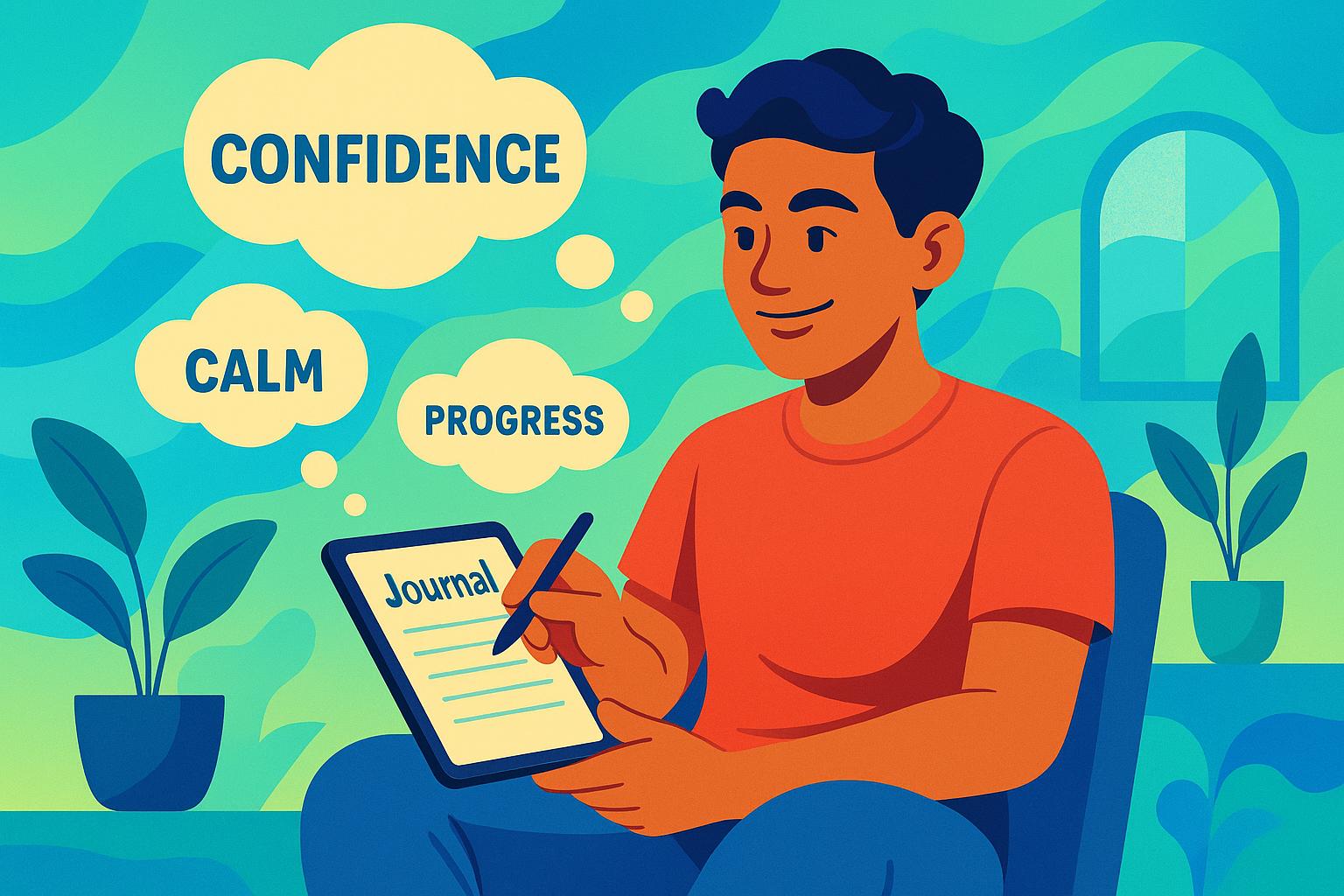Cyberbullying is a major issue affecting teens’ mental health, causing anxiety, depression, and even physical symptoms. Unlike face-to-face bullying, it’s constant, anonymous, and can reach a wide audience instantly. In 2023, 26.5% of U.S. teens reported being victims, with 93% experiencing negative mental health impacts, including anxiety and hopelessness. Girls and LGBTQ+ teens face higher risks, with many skipping school or avoiding social interactions due to fear and shame.
Key points:
- Cyberbullying is relentless, following teens everywhere through devices.
- Victims often feel powerless, leading to anxiety, depression, and isolation.
- 19.2% of teens skipped school in 2023 due to cyberbullying.
- Female and LGBTQ+ teens are disproportionately affected.
To manage anxiety, teens can:
- Block bullies, save evidence, and report incidents.
- Use tools like anxiety tracking apps.
- Seek professional help for persistent emotional struggles.
Parents and teachers play a critical role by recognizing warning signs, creating safe environments, and intervening early to protect teens from the long-term effects of cyberbullying.
Cyberbullying and Mental Health: Unseen Consequences of Social Media
What Is Cyberbullying and Who Does It Affect
Cyberbullying refers to repeated harassment through digital devices, aimed at causing psychological harm. Unlike traditional bullying, which typically happens face-to-face in specific settings like schools, cyberbullying can invade every part of a teen’s life through phones, tablets, and computers. This constant presence makes it especially harmful, as it’s difficult to escape.
The ability for harmful content to spread quickly online, combined with the anonymity often provided by digital platforms, worsens the emotional impact. Victims frequently feel exposed and powerless. Interestingly, studies reveal that 40% to 50% of those targeted by cyberbullying know the identity of their harasser.
A single damaging post or embarrassing photo can reach hundreds of people within minutes, amplifying feelings of shame and anxiety. Adding to the problem, cyberbullying often happens impulsively. A teen may send a cruel message in a moment of anger, not realizing the long-term damage it could cause.
Types of Cyberbullying
Cyberbullying can take on many forms, including:
- Harassment: Repeatedly sending threatening or hurtful messages through texts, emails, or social media, often involving name-calling or direct threats.
- Spreading Rumors: Sharing false or humiliating information about someone online, which can harm reputations and relationships.
- Impersonation: Using fake accounts to imitate the victim or hacking into their accounts to send offensive messages.
- Outing and Trickery: Publicly sharing someone’s private information or photos without their consent, breaking trust and violating privacy.
- Exclusion: Deliberately leaving someone out of online groups or conversations, creating feelings of isolation for teens who rely on digital connections.
Teens Most at Risk
Some teens are more vulnerable to cyberbullying due to social factors. A 2023 survey of 5,005 U.S. teens found that females face higher rates of cyberbullying. Girls, in particular, are more likely to experience multiple forms of online abuse, with 15% reporting at least four different types compared to 6% of boys.
LGBTQ+ teens also face heightened risks. About half report experiencing online harassment, and in 2021, nearly 30% of LGBTQ+ teens reported being electronically bullied, compared to 13% of their heterosexual peers. Racial and ethnic minorities are similarly targeted. For example, 21% of Black teens reported being bullied due to their race or ethnicity, compared to 4% of White teens and 11% of Hispanic teens. Additionally, 42% of students who experienced bullying cited factors such as physical appearance (30%), race (10%), gender (8%), disability (7%), ethnicity (7%), religion (5%), or sexual orientation (4%) as the reason for the harassment.
Teens with disabilities and those dealing with mental health challenges, such as anxiety or depression, are particularly vulnerable. The anonymity of cyberbullying often leaves victims feeling helpless, further intensifying its emotional toll. These factors underline the importance of targeted interventions to protect at-risk teens and address the lasting effects of cyberbullying.
How Cyberbullying Causes Anxiety in Teens
Why Cyberbullying Leads to Anxiety
Cyberbullying takes a heavy toll on teen mental health, reshaping how their brains handle stress and often leading to chronic anxiety. Unlike traditional bullying, cyberbullying follows victims everywhere – through their phones, computers, and social media. This constant exposure keeps the body’s stress response on high alert, which, over time, can result in long-lasting anxiety. Dr. Adam Pletter, a clinical psychologist and founder of iparent101.com, sheds light on the issue:
"Cyberharassment is both public and permanent which amplifies the upset…cyberbullying also leaves a digital tattoo (a more fitting term than digital footprint), resulting in years of distress and often direct mental health implications."
The anonymity of online harassment only makes things worse. Teens often don’t know who’s targeting them, which creates a sense of unpredictability and leaves them in a constant state of vigilance. This emotional exhaustion can spiral into social anxiety, making everyday interactions feel overwhelming.
Adding to this, the teenage brain is particularly vulnerable to peer rejection. The limbic system, responsible for processing emotions, develops earlier than the prefrontal cortex, which governs rational thinking. This imbalance means teens feel the emotional sting of cyberbullying more deeply, while lacking the tools to regulate their stress effectively.
Hurtful messages don’t just disappear; they replay in a teen’s mind, amplifying their anxiety. Many teens obsess over their social media interactions, worrying endlessly about what others might be saying about them online. As one teen explained:
"It’s worse because you’re thinking ‘what did I do wrong,’ is it something I did?’ And it’s in your brain, like you’re distracted."
This mental cycle sets the stage for the research-backed evidence of cyberbullying’s impact.
What Research Shows
Studies have consistently shown how cyberbullying harms teen mental health. A staggering 93% of victims report negative mental health effects, including heightened anxiety and even physical symptoms like stomachaches and headaches .
The statistics are sobering. Nearly 41% of children attribute social anxiety directly to cyberbullying, and 37% link their depression to online harassment. These aren’t fleeting emotions – these are serious mental health challenges that can persist long after the bullying stops.
Ali Goldstein, LMFT, highlights the connection between stress and physical symptoms:
"When someone is bullied they undergo a great deal of stress. One of the side effects of that kind of stress can be physical or somatic symptoms…This kind of response can cause long-term distress for the victim of the cyberbullying and is often confusing as they rarely know why they are feeling this way."
Cyberbullying doesn’t just affect mental health – it disrupts everyday life. Two-thirds of teens who experienced online harassment reported that it interfered with their ability to learn and feel safe at school. This shows how online attacks bleed into the real world, creating anxiety that impacts their academic performance and social interactions.
The most alarming finding? Victims of cyberbullying are four times more likely to engage in self-harm or suicidal behavior. Research indicates that cyberbullying increases suicidal thoughts by nearly 15% and suicide attempts by almost 9%. For some teens, addressing the anxiety caused by cyberbullying is not just about improving well-being – it can be a matter of survival.
Brain imaging studies add another layer of understanding. Cyberbullying has been shown to alter neural activity in areas responsible for empathy, emotional regulation, self-reflection, and reward processing. These changes often lead to lower self-esteem and increased self-criticism, effects that linger long after the bullying ends.
The emotional impact is just as striking. Over half of teens report feeling angry after being cyberbullied, about a third feel hurt, and nearly 15% feel scared. Among female victims, 66% experience a sense of powerlessness. This helplessness can easily evolve into chronic anxiety as teens feel unable to protect themselves from future attacks.
For teens grappling with these challenges, tools like the Anxiety Journal app can help. By logging episodes, tracking stress, and taking GAD-7 tests, they can gather valuable insights to share with mental health professionals.
How Cyberbullying Affects Daily Life
The effects of cyberbullying stretch far beyond the online world, creeping into nearly every part of a teen’s life. From struggling in school to feeling isolated from friends and family, the stress caused by online harassment doesn’t stay confined to screens. It seeps into daily routines, fueling anxiety and amplifying feelings of loneliness.
Effects on School Performance
Constant worry about online harassment can turn the classroom into yet another stressful environment. Victims often find themselves distracted, wondering if classmates have seen hurtful posts or messages. The numbers paint a stark picture: 41% of cyberbullying victims become less active in class, 24% report a decline in school performance, and 35% have had to repeat a grade after being targeted.
Sue Scheff, a family internet safety expert, highlights the link between cyberbullying and academic struggles:
"Students who have experienced digital harassment are less active in class and more likely to fall back a grade."
The emotional toll – depression, anger, and low self-esteem – makes it hard for teens to focus on their studies. Many cope by avoiding school altogether, as researchers from McLean Hospital explain:
"Bullying can make it harder for kids to succeed in the classroom. This can make it hard for them to keep up with their academic studies. If students are bullied regularly, they may not want to go to school or participate in school-related activities, like sports or field trips."
When school feels unsafe, academic performance isn’t the only thing at risk. Teens often withdraw socially, cutting off connections with peers, which only deepens their isolation.
Impact on Friendships and Self-Image
Social media, intended to bring people together, can become a source of loneliness for cyberbullying victims. Studies reveal that victims often report fewer friendships and feel more isolated from both parents and peers. This isolation stems from the way harmful online behavior ripples through social circles.
Dr. Eric Alcera, Medical Director for Hackensack Meridian Behavioral Health, explains why cyberbullying feels especially harsh:
"People will do and say hurtful or demeaning things online that they would never say in person… If a cyberbully decides to spread rumors or share embarrassing photos on social media, the words or images can go viral, hitting the radar of many more kids within minutes."
This viral spread often leads other teens to distance themselves from the victim, fearing they could become the next target. Friendships unravel, leaving victims to navigate their pain alone.
The damage doesn’t stop at friendships. About 32% of teens report having false rumors spread about them online, which can shatter their sense of identity and self-worth. Many victims lose trust in others, making it harder to form new relationships.
The emotional strain also takes a physical toll. Victims frequently experience insomnia, stomach problems, and disrupted eating habits. Feelings of powerlessness are overwhelming, with 93% of victims reporting negative effects like sadness, hopelessness, and fear. For many, the world feels unsafe, both online and offline.
To navigate these challenges, tracking anxiety and emotional patterns can be a helpful step. Apps like the Anxiety Journal allow teens to document how cyberbullying impacts their stress levels. This information can be shared with parents, teachers, or mental health professionals, offering a starting point for support and recovery.
sbb-itb-b1dedcc
Ways to Manage Anxiety from Cyberbullying
When cyberbullying triggers anxiety, taking quick and effective action can help teens regain a sense of control and reduce stress. These strategies offer practical steps for immediate relief while also building long-term resilience.
Coping Methods for Teens
The first step in dealing with cyberbullying is to disengage from harmful online interactions. Avoid replying to negative comments or engaging in heated online arguments. Instead, block the bully on all platforms and save evidence of their behavior – screenshots of threatening or embarrassing messages can be shared with a trusted adult, such as a parent, teacher, or counselor. Taking short breaks from social media can also provide a much-needed mental reset.
For quick stress relief, try simple physical activities followed by mindful breathing exercises, like the four-seven-eight method. These techniques can help calm anxiety in the moment. Additionally, practices like daily affirmations, positive self-talk, and assertiveness training can strengthen emotional resilience and prepare teens to handle future challenges. Reporting the bullying to the platform where it occurred is another important step to help prevent further harm.
Using Apps to Track Anxiety
Apps designed to track anxiety can help teens identify patterns in their emotions and pinpoint triggers. For instance, the Anxiety Journal app allows users to log daily entries, keep a record of anxiety episodes, and monitor their stress levels over time. This kind of consistent tracking can uncover trends – like heightened anxiety after spending time on social media – and these insights can be shared with a supportive adult or mental health professional to fine-tune coping strategies. If tracking reveals ongoing distress, it’s a clear sign that professional intervention may be necessary.
Getting Professional Help
If the emotional effects of cyberbullying become too overwhelming or persistent, seeking professional help is crucial. Signs like trouble sleeping, declining grades, or withdrawing from social activities may indicate the need for additional support. Start by consulting a primary care provider, who can guide families toward specialized care. School counselors and teachers can also serve as valuable resources. In urgent situations, crisis support is available through services like the 988 Suicide & Crisis Lifeline and the Trevor Project.
Therapies such as cognitive behavioral therapy (CBT) or dialectical behavioral therapy (DBT) can be especially helpful. These approaches teach teens how to manage their emotions, build healthier coping mechanisms, and rebuild self-esteem.
How Parents and Teachers Can Spot and Stop Cyberbullying
Parents and teachers are essential in identifying and addressing cyberbullying before it causes serious emotional harm. With 58% of victims choosing not to report cyberbullying, adults need to recognize the warning signs and create supportive environments where teens feel safe speaking up. Early intervention can help reduce the anxiety and distress caused by cyberbullying.
Warning Signs of Cyberbullying
Spotting cyberbullying often requires paying attention to changes in a teen’s behavior, which can show up in their digital habits, emotions, social interactions, academic performance, and physical health.
Digital behavior changes are often the first clue. Teens might suddenly stop using their devices, seem anxious when online, or become overly secretive about their digital activities. They may also avoid talking about what they’re doing online [30,31].
Emotional and social changes can also indicate trouble. Teens may appear sad, angry, or withdrawn. They might lose friends or avoid social situations [30,31,32]. In more extreme cases, they could make comments about suicide or feeling hopeless, or engage in dangerous behaviors like self-harm or running away from home.
Academic and physical signs are another red flag. A drop in grades, lack of interest in school, or a reluctance to attend social events could point to distress [30,31,32]. Teens may call or text from school asking to come home or complain of frequent headaches or stomach aches – sometimes even faking illness. Changes in eating or sleeping habits are also worth noting.
Creating Safe Environments Both Online and Offline
For teens to feel comfortable reporting cyberbullying, parents and teachers must work together to build trust and set clear expectations for respectful behavior. This includes fostering open communication and creating spaces where teens feel heard and supported.
In schools, staff should be trained to recognize bullying and enforce respectful behavior. Teachers can set ground rules for respect and responsibility, and classroom meetings can serve as a space for students to discuss concerns and find support. Research shows that when multiple adults consistently promote respect and inclusion, the message resonates more with students.
Practical steps for schools include monitoring areas where bullying is more likely to occur, rewarding students for acts of kindness, and establishing clear rules about bullying, along with immediate consequences for violations [34,35]. Since 23% of students report cyberbullying incidents to a teacher first, educators must be prepared to respond with care and action.
At home, parents can encourage open conversations to better understand their child’s experiences. Teaching kids about cyberbullying and advising them not to respond to or share threatening messages is key. Parents can also connect with their children on social media, use filters on devices, and maintain ongoing discussions about their online activities.
When incidents occur, collaboration between parents and schools is crucial. Reviewing evidence together and taking swift action can prevent further harm. Schools can assist by sharing documentation with parents and guiding them on how to report harmful content. Meanwhile, parents should report threatening messages to the police and keep records of any related emails, texts, or posts.
The American Psychological Association highlights the importance of creating a safe environment for children:
"Preventing and stopping bullying involves a commitment to creating a safe environment where children can thrive, socially and academically, without being afraid".
This shared commitment requires ongoing effort and teamwork among all adults involved in a teen’s life. By recognizing the signs of cyberbullying and taking decisive action, parents and teachers can help protect teens from lasting emotional harm.
Conclusion: Helping Teens Handle Cyberbullying and Anxiety
Cyberbullying is a growing concern, with 95% of teens spending time online and up to 40% reporting they’ve been victims of it. The link to anxiety is undeniable – 32% of those targeted experience stress symptoms, and 38% face emotional distress due to online harassment. Even more alarming, exposure to cyberbullying increases the risk of suicide by 50%.
Unlike traditional bullying, cyberbullying can happen anytime, anywhere. It’s often anonymous, spreads quickly, and reaches wide audiences, leaving teens feeling trapped and powerless. This constant exposure can significantly amplify anxiety. To address these challenges, a united effort is essential.
Parents, teachers, and communities all play a role in combating this issue. Schools, for instance, should integrate cyberbullying prevention into their policies and ensure staff are equipped to respond effectively when incidents arise. At home, parents can foster open communication, helping teens feel supported and safe.
For teens already dealing with anxiety from cyberbullying, tracking their symptoms can be a powerful tool. Apps like the Anxiety Journal allow teens to log their anxiety levels, track panic attacks, and monitor stress patterns. This kind of documentation not only helps them identify triggers but also provides valuable insights when seeking professional help. Combined with other coping strategies, it offers a practical way for teens to regain a sense of control.
Addressing cyberbullying requires consistent effort. By recognizing warning signs, building strong support systems, and equipping teens to manage anxiety, we can help protect them from long-term harm. Together, we can create safer digital spaces and empower teens to navigate the online world with greater resilience.
FAQs
How can parents and teachers recognize and address cyberbullying to reduce anxiety in teens?
Parents and teachers can spot cyberbullying by paying close attention to teens’ online habits and behaviors. Signs to watch for include withdrawal from social activities, noticeable mood swings, or hesitation to use their devices. It’s also important to encourage open discussions about their online interactions and keep a record of any troubling incidents, like harmful messages or posts.
When dealing with cyberbullying, it’s best not to respond to the bully directly. Instead, report the behavior to the platform where it occurred or to the proper authorities. Offering emotional support to the teen is crucial during this time. Teaching responsible online behavior and fostering a safe, understanding environment can go a long way in preventing future issues. For teens experiencing anxiety due to cyberbullying, tools like anxiety trackers can help them manage their stress and emotions more effectively.
How can teens cope with anxiety caused by cyberbullying, and how might tools like the Anxiety Journal app help?
Teens dealing with anxiety caused by cyberbullying can take practical steps to manage their emotions and regain a sense of control. The first step is to stay calm and avoid reacting impulsively. Retaliation often escalates the situation, so focusing on documenting incidents instead can be far more constructive. Reaching out to trusted friends, family members, or a counselor can also provide much-needed support and guidance during tough times.
Using tools like the Anxiety Journal app can make a real difference. This app allows teens to track their anxiety levels, log incidents, and identify patterns in their emotional responses. By gaining this kind of self-awareness, they can work on developing healthier coping strategies and building emotional strength. Regularly keeping tabs on their stress and anxiety through the app not only helps them tackle current challenges but also promotes better mental health in the long run.
Why are girls and LGBTQ+ teens more affected by cyberbullying, and how can we better support them?
Girls and LGBTQ+ teens often endure higher rates of cyberbullying, driven by societal pressures, harmful stereotypes, and discrimination. These negative experiences frequently lead to emotional struggles, including anxiety, depression, and, in severe cases, suicidal thoughts. This increased vulnerability is often tied to factors like lower self-esteem and the absence of inclusive support networks.
Addressing these challenges requires focused efforts. Building welcoming online communities, enforcing anti-bullying policies that specifically consider LGBTQ+ issues, and ensuring access to mental health resources are crucial steps. Additionally, promoting education around resilience and fostering community support can play a key role in making the digital world a safer and more inclusive space for everyone.
